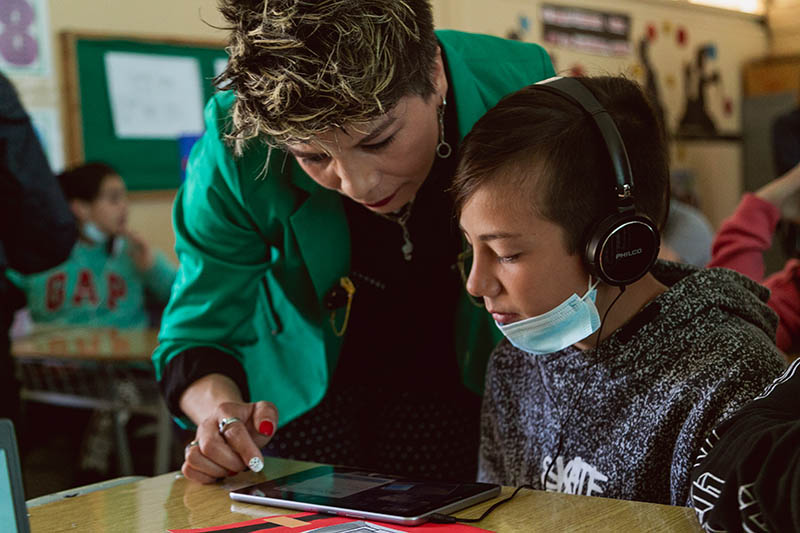The emergence of artificial intelligence in education is a phenomenon that’s transforming the way in which we learn and teach. Of course, as is always the case with all disruptive innovations, it has immediately generated a lively debate with mixed opinions in favour of and against it. On the one hand, there are those who regard AI as a powerful tool that can improve education and personalise the students’ learning more efficiently and effectively. On the other, some people fear that AI may have negative effects on education, such as exacerbating inequalities and eliminating jobs, and they are wary of its implications with regard to ethics, privacy and security.

The complexity of the issue, which involves numerous factors and perspectives, calls for a careful, well-informed, critical and balanced approach that takes into account both the benefits and the concerns. How can we reap its benefits and minimise its risks?
We’ve reached a crucial moment if we wish to, in the words of Stefania Giannini, Assistant Director-General for Education at UNESCO, “steer this revolution in the right direction with a view to improving livelihoods, reducing inequalities and promoting fair and inclusive globalisation”.
As a result, in 2019 UNESCO published the Beijing Consensus on Artificial Intelligence and Education, the first-ever document to provide recommendations on the best way of harnessing AI technologies for SDG 4 of the 2030 Education Agenda. We list the recommendations in this article.
The Consensus that was approved during the International Conference on Artificial Intelligence in Education states that the systematic integration of AI into education will allow us to address the major current-day challenges, innovate with regard to teaching and learning practices and, ultimately, accelerate the achievement of SDG 4. However, how can we make this happen?
Stefania Giannini
We’ve reached a crucial moment if we wish to steer this revolution in the right direction with a view to improving livelihoods, reducing inequalities and promoting fair and inclusive globalisation.
The text offers a series of recommendations to governments, international organisations and UNESCO itself, which, among other things, has a role to play in supporting education policymakers in implementing the recommended measures.
What are the recommendations for governments?
Systemic, multidimensional and funded planning. Plan and apply coherent system-wide strategies for the use of artificial intelligence in education; these must be harmonised and integrated into education policies within a permanent learning perspective. Be aware of the investment requirements for the implementation of artificial intelligence in education policies and programmes.
AI, data and education management. It will be necessary to take into account the major advances in the use of data to transform policy planning processes based on empirical data and use AI tools to fine-tune education management information systems to improve data collection and processing in such a way that education management and delivery becomes more equitable, inclusive, open and personalised.
AI and teacher support and training. Ensure that the AI technologies empower the teachers rather than replace them and create the appropriate programmes with a view to reinforcing their capacities to enable the teachers to work alongside the AI systems. Review and dynamically define the teachers’ roles and the competences they need within the context of teacher-related policies, reinforce the teacher training institutions and draw up the appropriate skill building programmes to prepare the teachers to work effectively in educational environments with a significant presence of artificial intelligence.
AI for learning assessment. Understand the trends in terms of the potential of artificial intelligence to support learning assessments by harnessing the potential of data in order to permit the assessment of multiple dimensions of the students’ skills and support large-scale and remote evaluations.
Development of values and skills for life and work in the age of AI. Prepare the next generation of workers by equipping them with the values and skills required for more relevant life and work in the AI era. Take institutional measures to improve the acquisition of basic artificial intelligence skills on all tiers of society.
AI and lifelong learning. Use AI tools to propose lifelong learning systems that facilitate personalised learning at any time, anywhere and for everyone.
Promotion of equitable and inclusive use of artificial intelligence in education. Ensure that artificial intelligence promotes high-quality education and learning opportunities for everyone, regardless of their gender, disability, social or economic status, ethnic or cultural origin or geographic location. The development and use of artificial intelligence in education must not aggravate the digital gap or demonstrate bias against any minorities or vulnerable groups.
Artificial intelligence with gender equity and artificial intelligence for gender equality. Promote gender equality in the development of artificial intelligence tools and equip girls and women with artificial intelligence skills to promote gender equality in the workforce in the area of artificial intelligence.
Ensure ethical, transparent and verifiable use of educational data and algorithms. Take into account that artificial intelligence applications may impose different kinds of biases inherent in the data upon which the technology is based and affect the way in which processes and algorithms are constructed and used. Bear in mind the dilemmas posed by balancing open access to data and the protection of data privacy. Adjust the existing regulatory frameworks or adopt new ones to guarantee the responsible development and use of artificial intelligence tools for education and learning.
Monitoring, evaluation and research. Support research, innovation and an analysis of the impact of artificial intelligence on learning practices and outcomes, as well as on the emergence and validation of new forms of learning.
The Consensus advises international organisations to:
AI development gap and disparities. Monitor and assess the impact of the gap and the disparities between countries in relation to the development of artificial intelligence.
Build partnerships and mobilise resources to close the artificial intelligence gap and increase investment in the application of artificial intelligence in education.
Reinforce exchanges of information and promising practices, as well as coordination and complementary measures among countries.
Provide appropriate platforms for international exchanges of information on regulatory frameworks, tools and approaches in relation to the application of artificial intelligence in education.






